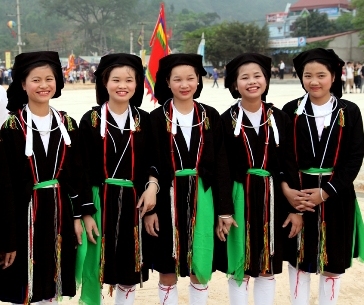The Vietnamese community has 54 different ethnic groups. Of which the Kinh (Viet) accounts for nearly 90% of the total population, more than 10% is the population of 53 ethnic groups.
The cultural of the ethnic groups is different to the other in community activities and in economic activities. From the costumes, eating, living, social relations, the customs of weddings, funerals, worship, festivals, calendars, arts and entertainment of each ethnic group brings together. It is hard work, smart in production; with nature - sticking to harmony; with the enemy - not tolerant; with human beings - post-humane, humble ...
* 54 ethnic groups living in Vietnam can be divided into 8 groups according to language
Lets Goodmorningvietnam explore Han Hoa Ethnic Group
1. Hoa ethnic group

Hoa ethnic group lives scattered across the provinces in both rural and urban areas. Hoa people works various occupations depending on the area where they reside, where they are also hard, creative workers and have much success in the commercial and service sectors.
At each the local where Hoa people concentrate in rural areas, which is common Minh Huong (Ming village) in the city live in the state are intertwined; houses are common professional typography, 3 rooms and two wings; maintain patriarchal family tradition with 4-5 family life.
Traditional Costumes of the Chinese people only see in some older people or in wedding ceremonies, funerals. In Chinese society, the relationship with the same people they were considered very important and each family has a way of worship. These operations, usually produce professional associations, respectively, of this opportunity and have an anniversary in the year. Some practices have to be reserved for marriage as parents determine the standard "suitable alliance". Funerals must be strictly complied from death information to leaving off mourning. Typically folk belief is ancestor worship, clan, family, worship gods bless (god of kitchen, god of the earth, god of good fortune, etc) and a number of saints, bodhisattvas, according to Confucianism, Buddhism, Taoism with pagodas, temples which are quite developed. Cultural activities, rich show, singing "nightingale" with many different themes, operas with a variety of musical instruments; Tet holidays dance lion, dance dragon, boxing and many traditional games.
2. Ngai ethnic group

Ngai people live in Bac Kan, Bac Giang, Cao Bang, Lang Son, Quang Ninh, Thai Nguyen, etc. Ngai people live inland, planting rice is to make main source of life, in addition they also grow corn, potatoes, cassava, livestock, etc. Division in coastal and island living by fishing mainly. Prime industrial occupations such as construction curtain, mat weaving, carpentry, masonry, wrought, brick, lime, etc also plays a significant role in the life of God.
Ngai people stay with various roofing architecture and materials and some in coastal areas and islands often live right on the boat. Small patriarchal family, in every village, the location of the largest family patriarch is dignified and plays a major role in solving neighborhood relations. Wedding etiquette has two steps as wedding and room entry ceremony, early marriage age, marital marriage is highly married. After the wedding, the bride resides at husband’s house. When dead, it is brought with burial things which he still lives to use; the funeral has many complex stages: Death information, placing in the coffin, burying, Museum, in the coffin, opening grave, etc. Ngai people often worship a lot of objects as ancestry, Buddhist god, forest ghost, souls of living beings, worship each different object, using different kinds of offerings. Ngai people have a rich folk art with art forms such as folk music, dancing and especially the oral literature.
3. San Diu ethnic group

San Diu ethnic group concentrate in the North Vietnam, in the region from the left bank of Red River from the east poured. Their villages are like Kinh village, surrounded with bamboo and between houses which usually have walls or fences. Agricultural economy is to plant wet rice and alluvial land, garden, exploiting forest products, raising cattle, domestic animal; catch fish, breeding fish, the brick and do handicraft, doing tile, forging, weaving, etc.
The traditional dress of woman includes black towel, long dress (single or dual), if it is dual coat, the inside coat is always white and the outside one is indigo, a little longer, red bib; white, pink or blue belt; pink , two-piece dress is the same hem; white hem. Men dress as Kinh, having a bun and scarf or wearing turban, long dark coat, white pants. In marriage, men and women are free to love, to learn, however, it is decided by their parents and when getting married they must considered whether age is suitable or not, then allowed to marry. Like many other ethnic groups, San Diu people sing love men and women that they called Soong Co, usually sung at night, the song has lasted for many nights.